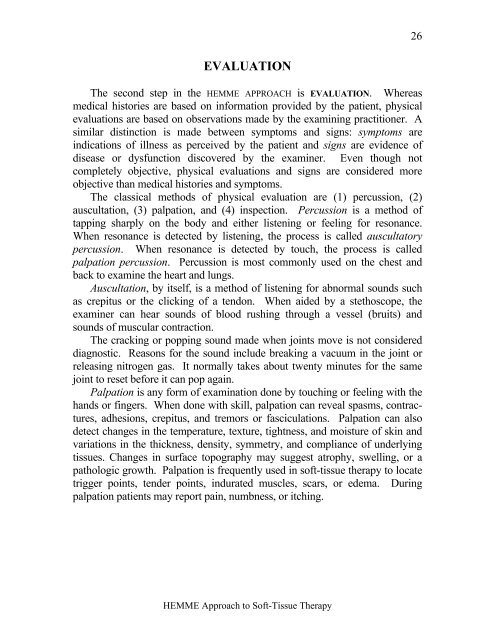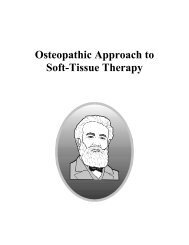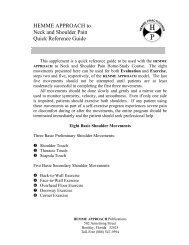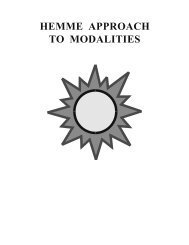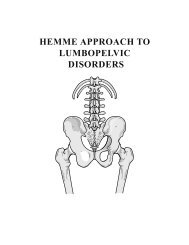HEMME APPROACH TO SOFT-TISSUE THERAPY
HEMME APPROACH TO SOFT-TISSUE THERAPY
HEMME APPROACH TO SOFT-TISSUE THERAPY
You also want an ePaper? Increase the reach of your titles
YUMPU automatically turns print PDFs into web optimized ePapers that Google loves.
26<br />
EVALUATION<br />
The second step in the <strong>HEMME</strong> <strong>APPROACH</strong> is EVALUATION. Whereas<br />
medical histories are based on information provided by the patient, physical<br />
evaluations are based on observations made by the examining practitioner. A<br />
similar distinction is made between symptoms and signs: symptoms are<br />
indications of illness as perceived by the patient and signs are evidence of<br />
disease or dysfunction discovered by the examiner. Even though not<br />
completely objective, physical evaluations and signs are considered more<br />
objective than medical histories and symptoms.<br />
The classical methods of physical evaluation are (1) percussion, (2)<br />
auscultation, (3) palpation, and (4) inspection. Percussion is a method of<br />
tapping sharply on the body and either listening or feeling for resonance.<br />
When resonance is detected by listening, the process is called auscultatory<br />
percussion. When resonance is detected by touch, the process is called<br />
palpation percussion. Percussion is most commonly used on the chest and<br />
back to examine the heart and lungs.<br />
Auscultation, by itself, is a method of listening for abnormal sounds such<br />
as crepitus or the clicking of a tendon. When aided by a stethoscope, the<br />
examiner can hear sounds of blood rushing through a vessel (bruits) and<br />
sounds of muscular contraction.<br />
The cracking or popping sound made when joints move is not considered<br />
diagnostic. Reasons for the sound include breaking a vacuum in the joint or<br />
releasing nitrogen gas. It normally takes about twenty minutes for the same<br />
joint to reset before it can pop again.<br />
Palpation is any form of examination done by touching or feeling with the<br />
hands or fingers. When done with skill, palpation can reveal spasms, contractures,<br />
adhesions, crepitus, and tremors or fasciculations. Palpation can also<br />
detect changes in the temperature, texture, tightness, and moisture of skin and<br />
variations in the thickness, density, symmetry, and compliance of underlying<br />
tissues. Changes in surface topography may suggest atrophy, swelling, or a<br />
pathologic growth. Palpation is frequently used in soft-tissue therapy to locate<br />
trigger points, tender points, indurated muscles, scars, or edema. During<br />
palpation patients may report pain, numbness, or itching.<br />
<strong>HEMME</strong> Approach to Soft-Tissue Therapy


